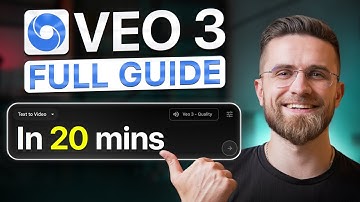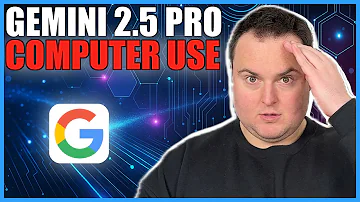Ultimate Guide to Google VEO 3: How Beginners & Developers Can Use The Next-Gen AI Video Tool
Google VEO 3 has taken the AI world by storm, offering next-gen text-to-video capabilities that empower both casual creatives and seasoned developers. Whether you're looking to generate short, engaging video clips with audio or build cinematic AI-powered projects, this guide will help you unlock the full potential of Google VEO 3—no matter your experience level.
What is Google VEO 3? (0:00–2:00)
Google VEO 3 is the latest AI-driven text-to-video model from Google. With just a descriptive prompt, you can generate up to 8-second video clips—complete with native audio, sound effects, and dialogue.
- Text-to-Video: Type your idea, and VEO 3 brings it to life.
- Native Audio: Unlike older models, VEO 3 doesn't stop at silent visuals. It can add crowd noise, dialogue, and background ambiance.
- Short-Form Content: Currently, clips max out at around 8 seconds, making VEO 3 perfect for social media, memes, and viral content.
“You type a description, and VEO 3 spits out an 8-second video clip with sound—yes, audio and video—from just your words.”
How to Access Google VEO 3 (2:00–4:00)
Getting started depends on your needs and location:
- Google Flow: Advanced interface for filmmakers and developers. Available via Google Apps for users with a Google AI Pro or Ultra subscription (Ultra unlocks full VEO 3 features).
- Gemini: Streamlined tool for quick, single-clip generation—ideal for beginners.
Step-by-Step: Getting Access
- Create a Google Account: Required for both Flow and Gemini.
- Choose a Subscription:
- Search "Google AI Pro subscription" or "Google AI Ultra subscription" for up-to-date signup links and feature lists.
- Check Regional Availability: Some features are region-locked; look for announcements on the official Google AI page.
Using Credits
- Most AI video services operate on a credit system. You can monitor and manage credits via the Google Cloud Console.
- For detailed instructions, search “Google Cloud billing documentation.”
Google VEO 3 for Beginners: Create Viral Videos in Minutes (4:00–10:00)
VEO 3 makes AI video creation accessible—even if you have zero filmmaking experience.
Key Features for Beginners
- Simple Prompting: Just describe what you want to see and hear.
- Audio Integration: Specify crowd noise, dialogue, or music directly in your prompt.
- Quick Results: Generate and iterate on ideas rapidly.
Example Workflow: Grandma Skydiving into the Super Bowl
- Subject: 80-year-old grandma in skydiving gear.
- Action: Parachuting from a plane into a packed Super Bowl stadium.
- Context: Championship game, crowd roaring.
- Motion & Framing: Wide aerial shot, slow-motion descent.
- Style: Cinematic, lighthearted, bright colors.
- Audio: Crowd noise, wind, grandma yelling "Yahoo!"
“To get the best results from VEO 3, craft your prompts like a tiny movie scene description.”
Actionable Tips
- Be Specific: The more detail you provide, the better the result.
- Use the Audio Double-Colon:
Audio::lets you clearly define sounds, e.g.,Audio:: crowd cheering, wind rushing, excited shouts. - Avoid Subtitles (if unwanted): Add "No subtitles" to your prompt if you don't want auto-generated text.
Google VEO 3 for Developers & Advanced Users (10:00–14:00)
For those seeking more control, Google Flow offers pro-level features:
Key Developer Features
- Storyboarding: Map out multi-shot sequences.
- Asset Management: Upload/generate reusable character images for visual consistency.
- Manual Camera Control: Adjust framing, movement, and transitions.
- Scene Builder: Extend and connect clips for seamless narratives.
- Prompt Engineering: Use detailed, structured prompts for precise results.
Example: Minions-Style Bank Heist in Tarantino Fashion
- Descriptive Prompt: “A band of small, yellow, cartoonish creatures resembling minions storms into a bank. The bank’s interior has marble floors and teller counters with a slight 1970s retro style. Wide shot as the front doors swing open, then slow-motion, low-angle shot of the characters striding in confidently, holding makeshift banana guns. The scene feels like a tense stick-up from a Quentin Tarantino film. Dramatic shadows, film grain effect, and an intense cool mood. Audio: funky 1970s heist soundtrack, creatures yell excited gibberish, bank alarm blares. No subtitles.”
- Result: VEO 3 applies the style cues for a cinematic, genre-specific video.
API Availability
- The video does not mention a public API for VEO 3 as of now. However, developers should monitor the Google Cloud documentation and Google AI blog for future API announcements.
Cost Considerations: What Does a 1-Minute Video Cost? (14:00–15:00)
- VEO 3 Pricing: Based on subscription tier (Pro/Ultra) and possibly credits consumed per video. Exact pricing is not public—check Google AI pricing for updates.
- Professional Production: Hiring freelancers or agencies can range from $100–$10,000+ per minute, depending on complexity.
- DIY Platforms: Tools like Canva or Animaker offer free/paid tiers, typically $10–$50 per month for premium access.
Tip: For budget-conscious creators, free alternatives (see below) can help you prototype and experiment before committing to paid AI services.
Free Alternatives to Google VEO 3 (15:00–16:00)
- RunwayML: AI-powered video generation with a free tier and creative tools.
- DeepAI: Open-source models for text-to-video and other creative AI tasks.
- Canva/Animaker: Easy drag-and-drop video editors with some AI features (limited compared to VEO 3).
How to Find Free Tools
- Search "free AI video generation tools"
- Explore open-source AI communities on GitHub
- Look for community reviews and tutorials on YouTube or Medium
Pro Prompt Engineering: Get Cinematic Results Every Time (16:00–18:00)
To maximize VEO 3’s capabilities, use a structured prompt formula:
Prompt Checklist:
- Subject
- Action
- Context (where/when)
- Motion (camera movement)
- Style (visual genre)
- Framing (shot composition)
- Constraints (length, tone, etc.)
- Audio (sound effects, music, dialogue)
“Be specific and vivid—describe what the camera sees and what the mic hears.”
Example:
- “A cowboy in a big hat rides a huge T-Rex dinosaur charging through downtown Manhattan. Camera circles around them in Michael Bay action style—high contrast, explosions, dramatic action music. Audio: roaring T-Rex, cowboy whooping, car tires screeching, explosion sounds.”
Conclusion: Key Takeaways & Next Steps
Google VEO 3 is revolutionizing AI video creation, making it accessible for everyone—from absolute beginners to professional developers. With its intuitive prompting system, support for native audio, and advanced tools for pros, VEO 3 sets a new standard for creativity.
Key Takeaways:
- VEO 3 turns text prompts into cinematic, sound-rich short videos.
- Beginners can start fast with Gemini; developers get advanced features in Flow.
- Mastering prompt engineering unlocks the best results.
- Explore free alternatives if you're just getting started or on a budget.
- Keep an eye on Google's documentation for API or pricing updates.
Ready to experiment? Share your wildest VEO 3 video prompt ideas in the comments—or try out a free AI tool while you wait for access!
Stay creative and keep experimenting—your idea plus AI might just be the next viral hit!


